
Arquivo para a ‘Museology’ Categoria
The dark night of humanity
Watching political debates or even relevant issues of public life, a brief look at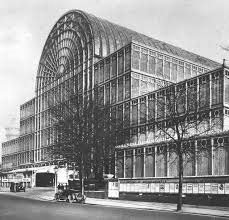 culture and religion, any angle that looks at the moment aggravated by the pandemic, it is relevant to point out the confused features of this civilizing moment.
culture and religion, any angle that looks at the moment aggravated by the pandemic, it is relevant to point out the confused features of this civilizing moment.
It is a fact that we have already been through another pandemic, in frightening numbers the so-called “Spanish flu” in the middle of the 1st. world war, it was a great and humanitarian disaster that challenged humanity, and even then came the second war, the concentration camps and the Hiroshima bomb, but the contours of this moment seem even more serious, there is a crisis of thought.
What can be observed are phrases made with a doubtful impact, appeals to impossible optimism in the face of the pandemic scenario or the hope “after all this is over”, however as the vaccine does not reach reality it imposes it, even on the wise on duty a little sobriety, but still without the solidarity and humanity that would be desirable.
The crisis of thought already pointed out by Edgar Morin, Nicolescu Barsarab and many others, in addition to the scientific and technical debate, is the difficulty of composing elements that should go beyond the limits of specialties to solve problems beyond the disease, the social and the religious, to tackle the problem together would require an overall view and not an impoverished disciplinary view of specialists.
When less is seen by pure and simple analysis, the darker this night becomes, the foundations lost, even if the civilizing foundations can be overcome: the Greek culture, the Judeo-Christian religiosity that so many scholars had, also the Islamic with Avicenna, Averroes, Al-Khwarismi and more recently Abdus Salam, who won the Nobel Prize in Physics in 1979.
Science is still strongly linked to the positivism and logicism of two centuries ago, while Karl Popper, Tomas Kuhn or Bachelard are still little known and confined in circles of “experts of the scientific method” which indicates a shallow reading of these questioners of conventional science.
The last century gave us Gustave Klimpt, Pablo Picasso, Henri Matisse, Salvador Dali, the bold architecture of Antoni Gaudi, by Brazilian Oscar Niemeyer, but the straight façades, the abuse of glass and crystals that appear for the first time in the Crystal Palace (photo), English architectural structure of the 19th century that invoked a recreation center for “education of the people”, cited by Sloterdijk and his disciple Byung Chul Han as representative of current architecture, as centers of consumption and “an architectural form was proclaimed as the key to capitalism . condition of the world ”(SLOTERDIJK, 2005, P. 279).
The Creator’s greatness and daily novelty are a stark contrast to repetitive, outdated religions that say nothing to the world today, about the pandemic oscillating between simple adherence to current discourse to models of solidarity and defense of life that are too fragile for tragedy pandemic.
SLOTERIJK, P. Crystal Palace, Chapter 33 of in Globalen Inneren Raum des Kapitals: Für eine philosophische Theorie der Globalisierung (In the Global Inner Space of Capital: For a Philosophical Theory of Globalization). Frankfurt am Main: Suhrkamp, 2005, pg. 265-276.
The historical origin of hiding pandemic data
The idea of hiding data about the pandemic had already occurred in the Spanish flu, which received this name only for political reasons since Spain remained neutral during the First World War, the original name was trench flu because it affected many soldiers and weakened some armies.
which received this name only for political reasons since Spain remained neutral during the First World War, the original name was trench flu because it affected many soldiers and weakened some armies.
The idea of hiding the disease was even supported by prestigious institutions, such as the Royal Academy of Medicine in London, until the end and 1918 few believed in the flu.
The name of Spanish influenza is also old, Brazilian newspapers (there was an article from the magazine A Careta, n. 537) used the name but as now the beginning of the fight against the disease was troubled, and the coercive measures defended by the sanitary Oswaldo Cruz were seen as a sanitary tyranny in the country and political groups opposed to the Wenceslau Braz (see the Brazilian daily) government saw the flu as a government pretext for intervention in the lives of the population.
Political use has also been made, but at this serious moment in history, it is desirable that true humanitarian spirits disarm themselves to defend the lives of the population, the action of doctors, aid groups and efforts for the vaccine.
The insistence on polarizing in such a tragic moment reveals only the decadence of the most expensive values of compassion and solidarity, even by groups that should be more committed to joining efforts, and curiously we find even those on the other side of both solidarity and those seeking divert attention from the real enemy: the pandemic that affects everyone.
In the country, lost the opportunity to do a #lockDown when the disease was still located in some regions, now it has spread throughout the country and only the measures already known should continue to be adopted, I see medical teams and support services reaching depletion , the cases of infection of this true heroes continue to grow.
What is new is a worldwide tension in truly worrying limits, the departure from abandoning the basic foundations of society and attitudes that vary between conformism and the simple abandonment of any measure of protection and social isolation, such as the march of thousands of people in Germany.
The levels of the pandemic in Brazil remain stable, neither is it true that the pandemic is under control, nor is it true that there is a genocide in the country, simply the measures that could be taken were not, and time passed and the disease spread.
We are left with the hope of the vaccine, that of Oxford, one of the most reliable due to scientific criteria, the transparency of the working scientists (a detailed article was published in The Lancet magazine) and the rigor of the vaccine’s release stages, without being hit.
The post-pandemic is frightening because there are no attitudes of sobriety and balance even in conscious sectors of society, the impression of a humanism that is more political than true.
Ignoramus et ignorabimus
The phrase of the German physiologist Emil du Bois-Reymond in his work meant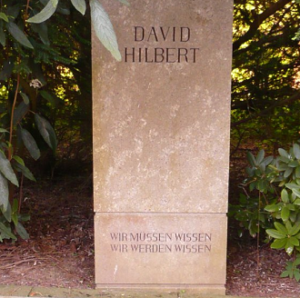 that in his Über die Grenzen des Naturerkennens meaning that in scientific knowledge there was ignorance and the Latin translation is ignored and we will ignore.
that in his Über die Grenzen des Naturerkennens meaning that in scientific knowledge there was ignorance and the Latin translation is ignored and we will ignore.
The first big reaction would come from David Hibert in 1930 when he said: “We need to know and we will know”, said at an annual meeting of the Society of German Scientists and Doctors, but at a round table at a Conference on Epistemology, Kurt Gödel provisionally announced his incompleteness theorem, which showed that elementary axiomatic systems are self-contradictory and contain logical propositions that are impossible to prove or disprove.
At a conference of mathematicians in Paris in 1900 he had announced the famous 23 problems that mathematics was supposed to solve, including the famous incompleteness theorem that would prove that a mathematical system is either complete or open.
However, the biggest problem was closing the questions around mathematical theorems and axioms, and the next big debate is the difference between human and social systems on the one hand, and systems of nature, physical or mathematical on the other.
So if we say that 2 plus 2 is four and this is accurate, it means that we are in the field of mathematics, just as geometric figures can be perfect, no “natural” system is exactly perfect, planets are not exactly round, light and waves Electromagnetic waves do not walk in a straight line in the universe and neither is any natural surface perfectly flat.
What we ignore means that our system of interpretation is limited to certain models and metaphors that do not correspond exactly to nature, and on the social level not only is man extremely complex but the nature that is where the set of human relationships takes place is still more complex, since it is the sum of individual complexities.
The epitaph on the grave of David Hilbert is his famous phrase:
“Wir müssen wissen.
Wir werden wissen ”. (photo above)
Matris in gremio, blood relationship and aorgic
To understand Sloterdijk’s digression 10, it is necessary to understand its 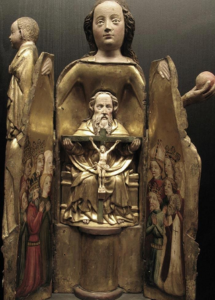 relationship with the tragedy, and a text that is certainly known to the philosopher is Hörderlin’s interpretation of the Greek tragedy Oedipus King of Sophocles, where he uses the aorgic term for the search for Epic to know who it is, the more it seeks the less conscious consciousness it becomes towards tragedy.
relationship with the tragedy, and a text that is certainly known to the philosopher is Hörderlin’s interpretation of the Greek tragedy Oedipus King of Sophocles, where he uses the aorgic term for the search for Epic to know who it is, the more it seeks the less conscious consciousness it becomes towards tragedy.
The tragedy is that father Laio, had heard from the oracle at Delphi, that his son would kill him and marry his mother Jocasta, the king hands him over to a poor shepherd to kill him, but the shepherd raises him and then he goes stop at the hands of Polybius, king of Corinth who raised him as a son, but the tragedy is fulfilled and then Oedipus kills King Laius who was his real father and marries Jocasta when he becomes aware of the blind truth, the tragedy has more details, here it is only to understand the aorgic.
However, Sloterdijk reverses this story and resumes Christian Mariology, in his tour 10 Matris in gremio (mother’s lap or lap), where after analyzing the text De humanitae conditionis in miseria by Lotário de Segni (1160-1216) that would later become if Pope Innocence III, who says that the liquid that would feed the child is the same as the menstruation that would be interrupted with pregnancy.
Sloterdijk, even though he does not believe that there are religions (so he does not have this question), will say “there is no doubt that Jesus, even in gremio, must have been provided with a different diet plan” (Sloterdijk, 2016, p. 557), and will use Question 31 from the third book of the Summa Teologica de Aquinas.
Aquinas’ argument is that “not even a better blood would have been enough to generate the body of Christ, because, by mixing with human semen, it becomes generally impure” (idem), and “… the communion of Jesus with on the contrary, the mother should be realized through blood that deserves to be classified as particularly chaste and pure ”, and quotes Tomás:
“… Because, by the action of the Holy Spirit, this blood is collected from the Virgin’s lap and formed into a fetus. That is why it is said that the body of Christ was formed by the most chaste and pure blood of the virgin.” (Aquino, Suma Theológica III, 31, 5, 3, SP: Loyola, 2001-2002).
Before Tomas de Aquinas, John Damasceno, who has already spoken of the Trinitarian pericoresis, will take this blood relationship between Maria and her fetus to the extreme, quoted by Sloterdijk: “Given that pericoresis always implies the primacy of the relationship over the outside place or precisely because the relationship itself founds the place where those who interpenetrate were found, Mary’s body cannot be buried after death in a usual way ”(SLOTERDIJK, 2016, p. 558).
And so the idea was born that Mary was taken to heaven, but it is also the birth 11 centuries before being accepted, the dogma of her Immaculate Conception (which by popular use became Conceição), thus “it is the very matrix of God who miraculously offered the sculptor the material of his sculpture, and to God the material to become a man… ” (Damasceno apud Sloterdijk, 2016, p. 558), which thus pre-announces the aorgic action of Mary with Jesus and God-Father, as a pericoresis in extremis (in the photo, also used by Sloterdijk, Virgin with Overture, late 14th century, Cluny Museum in Paris).
SLOTERDIJK, P. (2014) Bubbles: Spheres Volume I: Microspherology. UK: Semiotext(e).
Translatio studiorum and writing techniques
The long period that went from the beginning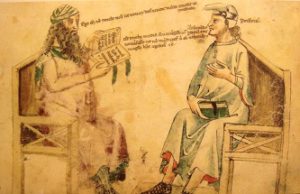 of registered writing, scriptura, until the appearance of copyists, called mixed orality, is called translatio studiorum, where writing itself will undergo many technical variations, and in them stand out São Jerônimo who compiled and elaborated the first version of the Bible.
of registered writing, scriptura, until the appearance of copyists, called mixed orality, is called translatio studiorum, where writing itself will undergo many technical variations, and in them stand out São Jerônimo who compiled and elaborated the first version of the Bible.
During this period, the so-called Cappadocian priests stand out, Gregorio de Nissa (335, died in 394), his brother Basilio the Great, and Gregório de Nazianzeno, whose writing is important for what both Hannah Arendt and Byung Chull Han will analyze in the vita active, and here the information is linked in times of new media, but it will be done during the week.
Translation Studiorum, period of transfer of knowledge, from one era to another when the techniques of culture are changing, and thus their anthropotechnics, between different cultures and religions, especially in the West and the Middle East, where there is the culture of the original of the book of three great Abrahamic religions (comes from Father Abraham), the Koran, the Torah and the Bible.
The translatio thus corresponds to the period of peak and decadence of Greek-Christian thought, which has more links than is apparent, and which would be preserved and would continue in the Western world in the form of a dominant and influential philosophical and Trinitarian and Neoplatonic doctrine.
De Trinitate de Saint Augustine is as revealing as his popular book Confessions, and Plotinus’ influence cannot be denied, nor can it be overvalued, it is not denied because Plotino’s conception of One of the soul is essential, and overvalued because Augustine’s conversion displaces him from Plato’s deontological center, Sumo Bem, to the ontological: the person and Trinitarian of Christian thought.
However, Cappadocian priests bring concepts that can be explored in the light of current thinking, Ousía (οὐσία, correct pronunciation is “ouceea”), is translated a noun from the Greek language giving rise to essence and substance, but semse feminine and conjugation in the present participle of the verb “to be”, the Heideggerian interpretation is “present” or present (being-present).
We will also explore the meaning of the word hypostasis, from the Greek prosopon, it comes from Greek theology with the meaning of person, and in conjunction with ousia it gives a meaning to the Trinitarian.
The pandemic and the sign of Jonah
Nínive (present-day Mossum) was one of the largest cities during the Assyrian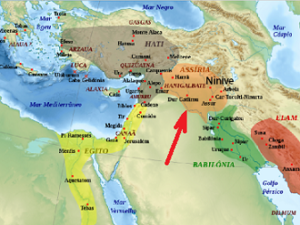 reign, by the standards of the time it had more than 100,000 inhabitants and was quite extensive since the Bible reveals that Jonas took 3 days to explore it and ask for the change of conduct of its inhabitants.
reign, by the standards of the time it had more than 100,000 inhabitants and was quite extensive since the Bible reveals that Jonas took 3 days to explore it and ask for the change of conduct of its inhabitants.
The date on which the preaching took place in Nineveh is uncertain and the author of the book that bears the name of this prophet is also unknown, but as it refers to the reign of Jeroboam II as king of Israel, the date must be between the years 700 and 742 BC, by writing the text in Aramaic typical of late Hebrew, both in style and in grammar, it is post-exile which means between 722 and 742 BC
From the end of the 17th century BC (when the Neoassirian Empire fell), until the middle of the 7th century, it was a geopolitical entity, ruled by other peoples, the Assyrians were known for their wickedness and violence, where they could even kill for debt, and the biblical narrative said that the prophet Jonah, who was to preach and ask for the change and conversion of the people, was afraid to do his mission.
It is not known for sure what was the plague that could come to the people there, but the people including the king all changed their attitude and converted, and the plague did not happen in that region, the current pandemic already has its sign of changing habits and the demand for solidarity with everyone, but there are still those who think that the pandemic will pass without any change in attitude.
The history books do not record exactly what the change was, but it was during the government of Assurbanipal, son Assaradão, who died in 667 BC, that Assiria lived its most profitable period, including the first Library of history, precisely the Library of Nineveh, which is where thousands of texts are found (chronicles, royal letters, decrees, religion, myths and many others) written on a baked clay tablet.
The change that we need not only to avoid the number of deaths that grows, ranges from personal habits to the concern with food and life maintenance of those who no longer had jobs, those who now do not have and those who must lose with the growth of pandemic.
For those who believe, they must also rethink what they believe and experience what they believe, otherwise it is just a legend or fable told as a beautiful story.
The golden book
Written in 1962 and considered one of the great novels of the 20th century, the  Golden Book (O Caderno Dourado in Spanish, in the photo), tells the story of Anna Wulf, a writer immersed in a personal crisis who decides to tell her story, from the black book for his literary life when he lived in South Africa, the red book on his left-wing political activism, the yellow his emotional life and the blue his daily life.
Golden Book (O Caderno Dourado in Spanish, in the photo), tells the story of Anna Wulf, a writer immersed in a personal crisis who decides to tell her story, from the black book for his literary life when he lived in South Africa, the red book on his left-wing political activism, the yellow his emotional life and the blue his daily life.
Doris Lessing, who won the Nobel Prize for Literature at the age of 85 (2007) when she expected nothing more, herself made a joke about it, but the recognition was deserved and little is known today of this consequent feminist and who refused to adhere to fashions and conjunctures followed his struggle.
Themes such as friendship, motherhood and sexuality have much deeper tones and outlines in this author, in novels such as “As grandmothers” (2007) where old age is seen in a different light, especially for women, or about politics in its book “The sweetest dream” that she suggests as an autobiographical one, and that reflects deeply on her humanitarian vision.
But if I had to highlight a novel by her, my favorite of the youth “Prisons we choose to live in” (1987), it attacks in a subtle and extraordinary way the question of political rhetoric (or what was decided to be politically correct) where it instigates individuals to come out of social constraints and build a better world, in fact and above everyday fashion.
He does not fail to attack in this novel ignorance and the lack of personal responsibility in the desire for applause and mere repetition of mottos, how current his speech would be, anticipating the times, because it was precisely because of the excess of rhetoric and the absence of concrete acts that we fell into pitfalls and we help contemporary ignorance and demagogy.
His sentence that seems to sum up his thinking was: “I cannot and will not hurt my conscience just to adhere to the fashion of the day”, and he said this not for conservatives, but for the apparently advanced positions of his time that were not directed towards attitudes concrete.
Tragedy and the arts
I am not speaking here of tragedy in the ordinary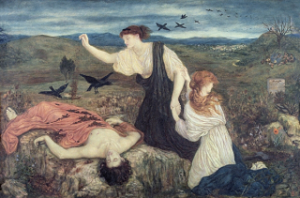 sense, but as an artistic category that is not only important for understanding the arts and beautiful Greek, but is claimed as a new idea of tragedy “as proposed by Hölderlin, Hegel or Nietzsche.” (Ranciére, 2009, p. 25).
sense, but as an artistic category that is not only important for understanding the arts and beautiful Greek, but is claimed as a new idea of tragedy “as proposed by Hölderlin, Hegel or Nietzsche.” (Ranciére, 2009, p. 25).
Just as Byung Chul Han in “The Salvation of the Beautiful” will problematize the dualism between contemplation and action, typical of modern philosophy that separates subject from object, Rancière penetrates further by proposing his “aesthetic revolution”, stating that what is there is “The abolition of an ordered set of relations between the visible and the sayable, knowledge and action, activity and passivity” (Ranciére, 2009, p. 25).
I said this when analyzing the Oedipus of the “psychoanalytic revolution” that invalidates “those of Corneille and Voltaire and who intends to resume – beyond the French tragedy, as well as the Aristotelian rationalization of tragic action – as the tragic thought of Sophocles” (idem , p. 25).
Ranciére will discuss in the following pages of his chapter on the “aesthetic revolution” on psychoanalysis saying that it is “invented at that point in which philosophy and medicine are mutually questioned to make thinking a question of disease and disease a question of thinking ” (Ranciére, 2009, p. 25), in paint above Marie Spartali Stillman (1844–1927),.
A large part of modern neo-therapies (I call exoteric psychoanalysis) go around, as if the problem of idealistic thinking was “disease” and a large part of human suffering could be solved as “thought” transforming it into disease.
This happens due to a bad relation with the thinking of tradition, late modernity is nothing but the bad reading of rationalism and idealism, or the delayed reading of empiricism, the thinking of Hanna Arendt’s “active” action, expressed in Byung Chul Han , is also part of the thinking of tradition that Ranciére will identify in the “representative regime as an absolute power of making” (Ranciére, 2009, p. 27).
It clearly identifies this regime in Baumgarten’s discourse on “confused clarity”: “in the aesthetic regime, this identity of knowledge and non-knowledge, of acting and suffering, which… constitutes the very way of being of art ”(Idem, p. 27), of course this is the art of tradition. And so it says, that the aesthetic revolution had already started with Vico, in his New Science, who against Aristotle and the representative tradition, although Rancière knows that his problem was not the theory of art, but the theological-poetic problem of “ wisdom of the Egyptians ” about hieroglyphs.
What place does aesthetics occupy in our time
I imagined that it would be difficult, even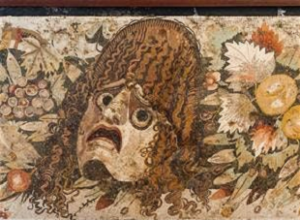 impossible, to approach the subject, since it is concerned with art critics of various types, Freudian psychoanalysts and very rarely anyone with our aesthetic, in the sense of beautiful Greek, or the contemplation of which Byung Chull speaks Han.
impossible, to approach the subject, since it is concerned with art critics of various types, Freudian psychoanalysts and very rarely anyone with our aesthetic, in the sense of beautiful Greek, or the contemplation of which Byung Chull speaks Han.
I found in a small text by Jacques Rancière, I am increasingly meeting this author, who came to know his work almost by chance (The emancipation of the spectator), referring to the theme as the aesthetic unconscious, but he himself explains it at the outset. psychological aspect of the theme.
I find right at the beginning of the book: “aesthetics does not deal with science or the discipline that deals with art.
Aesthetics designates a way of thinking that deals with the things of art ” (Rancière, 2009, p. 11) and this would be enough, but it complements their thinking and that they seek:“ to say what they consist of as things of thought. ” ( Rancière, 2009, p. 12).
It is a finding, but it could not be otherwise in a dialogue with the Kantian “tradition”, the following complement follows, saying that art as a thought is a recent reference and refers to the work Genealogy of art by Baumgarten of 1790 as the criticism of the Faculty of Judging of Kant.
From Baumgarten, a simple reference in his work would suffice, referring to the union of objects that “must be thought in a beautiful way with causes and effects, as this union must be sensitively known through the analogue of Reason” (Baumgarten, 1933 , p. 127) and so both he and Kant will establish “confused thinking” about the definition of aesthetics.
Rancière will say that both when calling Kant’s confused or heterogeneous sensitive thought, both will make art “no more than a minor knowledge, but a knowledge of what is not thought” (Rancière, 2009, p. 13) and the note of author will link it to enlightenment and liberalism.
There is no explicit reference to Nietzsche’s thought about art, but when discussing Oedipus, the most typical Greek tragedy and Nietzsche defends its role in art, he says about the Freudian use of this tragedy as “universal”, which at the same time encompasses three aspects: “a general tendency of the human psyche, a determined fictional material and a dramatic scheme considered exemplary.” (Rancière, 2009, p. 15).
Of course, this is only introductory, what Ranciére wants to explain is that it is not a matter of subjective or “confused knowledge”, but “a paradoxical union of disease and medicine that is, a paradoxical union of the two” (p. 26) in a reference to “The birth of tragedy” of the Nietzsche, what idealism as thought and romanticism as “aesthetics” want to deny.
Rancière, J. (2009) O inconsciente estético. trad. Monica Costa Netto. São Paulo: ed. 34.
Bruno, besides the heretic
I read in my youth Giordano Bruno’s “La cena de las cenizas”, one of six dialogues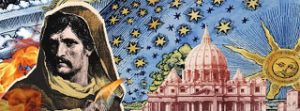 written in Italian, written during his two-year stay in London (1583-1585).
written in Italian, written during his two-year stay in London (1583-1585).
The Dominican priest discussed the Copernican Revolution in this book, and although he was accused of heretic, his discussion was no other than Christian eschatology in his worldview beyond his time glimpsing the ways of the infinite world and his view of God.
He paid with his own life, being burned alive on February 17, 1600 in Rome, but all his commentators claim that their dialogue opened the way for a new link between the paths of cosmology and philosophy, but contrary to the medieval Christian worldview.
His philosophy went beyond the limitations of reason (mathematical and logical) using for his bold vision an amalgamation of basic facts and cosmic reality, but without neglecting a reflection that led to humanistic action.
Also fleeing empiricism and using mental experiments from which he deduced the ramifications of his worldview, some interpreters claim that he used reasoning similar to what Einstein used for his intuitions about the universe.
Referring to the cosmos as infinite reality, Bruno went beyond the spheres of Aristotle and Ptolemy, to him as well as to Kepler, Paracelsus and Nicolas de Cusa the universe is a living being that holds an essential unity that unites all particular beings, which are but emanations of the whole, this cosmological view influenced the entire Renaissance.
His worldview, which did not triumph in the Renaissance, perished and was interrupted by the emergence of Cartesian reason, Hume’s idealism and empiricism, but deserves to be reread and studied as a strong influence on Renaissance thought.
Here’s what was said about Giordano Bruno in the famous cosmos series:
https://www.youtube.com/watch?time_continue=6&v=XzTREw3AKEQ&feature=emb_logo

